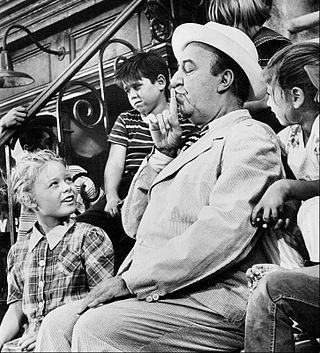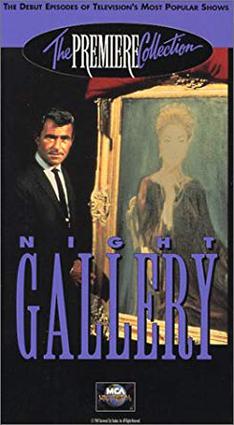Related Research Articles

Rodman Edward Serling was an American screenwriter and television producer best known for his live television dramas of the 1950s and his anthology television series The Twilight Zone. Serling was active in politics, both on and off the screen, and helped form television industry standards. He was known as the "angry young man" of Hollywood, clashing with television executives and sponsors over a wide range of issues, including censorship, racism, and war.

"One for the Angels" is the second episode of the American anthology television series The Twilight Zone. It originally aired on October 9, 1959, on CBS television.
"Walking Distance" is episode five of the American television series The Twilight Zone. It originally aired on October 30, 1959. The episode was listed as the ninth best episode in the history of The Twilight Zone by Time magazine.
"Escape Clause" is episode six of the American television anthology series The Twilight Zone. It is "the story of a strange contract between a mortal man and his most satanic majesty"; it originally aired on November 6, 1959, on CBS.

"Mirror Image" is the twenty-first episode of the American television anthology series The Twilight Zone. It originally aired on February 26, 1960, on CBS.

"The After Hours" is episode thirty-four of the American television anthology series, The Twilight Zone. It originally aired on June 10, 1960, on CBS.

"Twenty Two" is episode 53 of the American television series The Twilight Zone. The story was adapted by Rod Serling from a short anecdote in the 1944 Bennett Cerf Random House anthology Famous Ghost Stories, which itself was an adaptation of "The Bus-Conductor", a short story by E. F. Benson published in The Pall Mall Magazine in 1906. It was one of the six episodes of the second season which were shot on videotape in a short-lived experiment aimed to cut costs, and was directed by Jack Smight.
"The Midnight Sun" is episode 75 of the American television anthology series The Twilight Zone, first shown in November, 1961.
"He's Alive" is episode four of the fourth season of The Twilight Zone. It tells of an American neo-Nazi who is visited by the ghost of Adolf Hitler. Writer Rod Serling scripted a longer version of the teleplay to be made into a feature-length film, but it was never produced. This episode is notable for Dennis Hopper's breakout performance as Peter Vollmer.

Twilight Zone: The Movie is a 1983 American science fiction anthology film produced by Steven Spielberg and John Landis. Based on Rod Serling's 1959–1964 television series of the same name, the film features four stories directed by Landis, Spielberg, Joe Dante, and George Miller. Landis' segment is an original story created for the film, while the segments by Spielberg, Dante, and Miller are remakes of episodes from the original series. The film's cast includes Dan Aykroyd, Albert Brooks, Scatman Crothers, John Lithgow, Vic Morrow, and Kathleen Quinlan. Original series cast members Burgess Meredith, Patricia Barry, Peter Brocco, Murray Matheson, Kevin McCarthy, Bill Mumy, and William Schallert also appear in the film, with Meredith assuming Serling's role as narrator.
"Caesar and Me" is episode 148 of the American television anthology series The Twilight Zone starring Jackie Cooper as a ventriloquist. It is not to be confused with a similar episode "The Dummy", starring Cliff Robertson as a ventriloquist.
"The Bewitchin' Pool" is the 156th and last episode of the first incarnation of the American anthology television series The Twilight Zone. It originally aired on June 19, 1964 on CBS.
"Five Characters in Search of an Exit" is episode 79 of the television anthology series The Twilight Zone. It originally aired on December 22, 1961.

"The Fugitive" is episode 90 of the American television anthology series The Twilight Zone.
"Stopover in a Quiet Town" is episode 150 of the American television anthology series The Twilight Zone starring Barry Nelson and Nancy Malone. It originally aired on April 24, 1964.

The Nightmare Room is an American children's anthology horror series that aired on Kids' WB. The series was based on the short-lived children's book series that went by the same title created by Goosebumps author, R. L. Stine. The Nightmare Room originally aired from August 31, 2001, to March 16, 2002, in the United States.
Twilight Zone: Rod Serling's Lost Classics is a 1994 American made-for-television fantasy supernatural horror film consisting of two stories by Rod Serling. The film was co-produced by Serling's widow Carol Serling. Reportedly, she found the two pieces in a trunk in the family's garage.

Night Gallery is a 1969 American made-for-television anthology supernatural horror film starring Joan Crawford, Roddy McDowall and Richard Kiley. Directed by Boris Sagal, Steven Spielberg and Barry Shear, the film consists of three supernatural tales that served as the pilot for the anthology television series of the same name, written and hosted by Rod Serling. Serling garnered the Edgar Award for Best TV Episode for this effort. The film originally premiered on NBC on November 8, 1969.
Elizabeth Teresa "Terry" Burnham was an American actress, best known for her performance in the Twilight Zone episode "Nightmare as a Child".
References
- ↑ "Terry Burnham - Nightmare as a Child". twilightzonemuseum.com. Retrieved Oct 7, 2019.
- ↑ Presnell, Don; McGee, Marty (2008). A Critical History of Television's The Twilight Zone, 1959-1964. McFarland. p. 61. ISBN 978-1-476-61038-2.
- ↑ "Terry Burnham - Nightmare as a Child". twilightzonemuseum.com. Retrieved Oct 7, 2019.
- ↑ Presnell, Don; McGee, Marty (2008). A Critical History of Television's The Twilight Zone, 1959-1964. McFarland. p. 61. ISBN 978-1-476-61038-2.
- ↑ "Rod Serling's 1968 Binghamton High Commencement Speech". Archived from the original on 2017-05-19. Retrieved 2017-06-16.